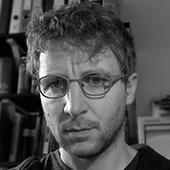
Private: Dr Patrick Allo
Former
patrick.allo@vub.ac.be
A few months ago I was invited to enter in a dialogue with Brussels-based artist Rossella Biscotti for the occasion of the exhibition of her installation “Other” from 2015 at the Contour Biennale in Mechelen (Belgium). In this work, she uses the Jacquard weaving technique to visualise data from Belgian census data, and engages in an exploration of data-subjects that are categorised as ‘other’ within this data-set. The resulting installation consists of 4 large carpets that display data of various minority-groups and rest-categories of the Brussels population.
My role in this collaboration was to contribute formal or mathematical insights on how rest-categories like other or none of the above could be understood. In this blogpost I reflect on this collaboration, and discuss how artistic research like Biscotti’s can contribute to the critical evaluation of contemporary data-practices. In a companion blog-post I will elaborate on how logico-mathematical insights can become part of such inquiries.
Biscotti’s 10×10 installation, the precursor of Other, was originally designed and produced to be exhibited at Haus Esters in Krefeld (Germany)—a modernist villa designed by Ludwig Mies van der Rohe for the silk-manufacturer Josef Esters—, and integrates multiple modernist ideals in a single work of art. In this work, Biscotti explores how institutional structures are imposed on individuals by combining features of automated mechanical manufacturing with conceptual and technological aspects of how large data-sets are collected and processed. She focuses in particular on how categories are used to create an overarching structure, and relates this to the punch-cards used to implement such structures within industrial (the Jacquard loom; an early 19th century device that automated the weaving of several complex patterns) and administrative (the Hollerith tabulator) processes that became increasingly automated in the early 20th Century. By showing the resulting work in Haus Esters, it becomes part of a more encompassing modernist narrative exemplified by Mies van der Rohe’s architecture.
For the exhibition of this installation at Contour, Biscotti’s team wished to extend their research with a more rigorous expression of the logic behind uses of rest-categories like other, and capture this logic in a single formal expression. This led us to a brief excursion into the meaning of the labels we use to designate such rest-categories, and suggested that we should interpret these labels as semantically empty labels that share certain features with the sentinel values that data-scientists now use to signal that certain data are missing. By asking how such empty labels interact with the generation (and ensuing reification) of categories, for instance when data are aggregated, we came to an interpretation of rest-categories as sets of data-subjects whose members should not, due to the lack of positive evidence of their similarity, be subsumed under a single kind or profile.
The recurrent attention for minority-groups and rest-categories, as well as the value accorded to automated and/or mechanical processes, naturally place Biscotti’s work within the scope of current debates on large-scale data-processing and the data-revolution. Mechanical objectivity and data-shadows are, for instance, current topics of interest within the scholarly community that tries to understand and assess the ethical, legal, and social implications of the data-revolution. And yet, the artistic research that led to 10×10 and Other deliberately only investigates historical computational technologies like the punch-card, and remains focused on the functioning of categories in census-data, which is itself a very traditional form of large-scale data-collection and organisation. It is, therefore, not immediately clear how Biscotti’s work, which (unlike the work showed at last year’s Big Bang Data at Somerset House in London) remains silent on matters like Big Data and machine learning, can contribute to our understanding of what we now see as the most salient features of the data-revolution.
What I’d like to suggest is that taking early manifestations of automated data-processes as an object of study can help us to open up new ways of questioning data-centric forms of knowledge-production, for instance by making us aware of practices that have become too familiar to deserve a critical assessment. Punch-cards and tabulators are, in that sense, similar to pre-cinematic processes: they are basic mechanical devices we study to understand the technologies that, respectively, enable contemporary artistic and documentary practices (cinema) or that enable novel epistemic practices. As such, it (re)directs our attention to the technological changes that make epistemic practices possible, or even just conceivable. It becomes a genealogical project, and has the potential to identify the technical and conceptual changes we need to be aware of to understand contemporary practices, by exposing us again to the historical building blocks of our current practices.
Biscotti’s work helps us, at the same time, avoid certain distractions. It can encourage us to look underneath the reigning rhetoric on Big Data, the mythical abilities that are often attributed to machine learning and artificial intelligence, and perhaps even the most rudimentary principles of inferential statistics. It invites us to take a few steps back—back into what we think of as known territory—, and draws our attention to the practices and assumptions that make data-driven inquiry and decision-making possible: recording, organising and processing through counting, categorisation, and automated calculation. Because artistic research like Biscotti’s is situated at the periphery of current scholarly debates, it isn’t bound by a given research-agenda and can reinvestigate familiar and often widely trusted practices, and ask elementary questions anew; from a contemporary (artistic) perspective. This includes questions that may have lost their immediate relevance because they no longer drive our scientific or scholarly curiosity, but also questions that are not aligned with the dominant themes of ongoing debates concerning privacy, fairness, transparency, or responsibility.